
Plastic surgery is a medical specialty focused on the restoration, reconstruction, or alteration of the human body. It includes both reconstructive surgery and cosmetic (aesthetic) surgery, each with its own goals and applications.
1. Reconstructive Surgery
Reconstructive surgery is aimed at restoring or improving the function and appearance of body parts that have been affected by injury, disease, or congenital conditions. This type of surgery is often necessary for medical reasons and can help to:
- Repair Damage: Repairing body parts that have been affected by trauma (e.g., facial fractures, burns, or amputations).
- Treat Congenital Defects: Correcting birth defects such as cleft lips, cleft palates, or other deformities.
- Restore Function: Reconstructing body parts after the removal of tumors or cancerous tissue, such as breast reconstruction after mastectomy.
- Improve Quality of Life: Restoring function and appearance to improve a person’s ability to perform daily activities.
2. Cosmetic (Aesthetic) Surgery
Cosmetic surgery is elective and performed to improve a person’s appearance, often for personal or aesthetic reasons. Procedures aim to enhance the natural features or reduce the visible signs of aging. Popular cosmetic surgeries include:
- Facial Procedures: Like rhinoplasty (nose reshaping), facelifts (to tighten and lift the skin), or eyelid surgery (blepharoplasty).
- Body Procedures: Liposuction (fat removal), tummy tucks (abdominoplasty), and breast augmentation or reduction.
- Non-Surgical Procedures: These include Botox injections, dermal fillers, and laser treatments for skin improvement, often with minimal downtime.
Goals of Plastic Surgery
- Function Restoration: Reconstructive surgery is designed to restore the function of the body or to repair physical deformities caused by accidents, disease, or congenital conditions.
- Appearance Enhancement: Cosmetic surgery helps individuals improve or alter their appearance to boost self-esteem and confidence.
Risks and Considerations
As with any surgery, plastic surgery carries certain risks:
- Complications: Infection, bleeding, or reactions to anesthesia are common risks.
- Scarring: Although surgeons make efforts to minimize scarring, it is often an unavoidable part of the process.
- Recovery Time: Surgical recovery may involve bruising, swelling, and a restricted ability to perform normal activities.
- Psychological Impact: It’s important for patients to have realistic expectations about the outcomes of surgery. Some may experience emotional or psychological effects depending on the results.
Choosing the Right Surgeon
It’s crucial to select a board-certified plastic surgeon, especially for cosmetic procedures. Board certification ensures that the surgeon has received specialized training in plastic surgery and has passed rigorous exams to demonstrate their knowledge and skills.
Before undergoing plastic surgery, it’s important to:
- Research the procedure thoroughly.
- Have a detailed consultation with the surgeon to understand the risks, benefits, and expected results.
- Ensure that the surgeon has experience in the specific procedure you’re considering.
In summary, plastic surgery is a diverse field focused on both reconstructive and aesthetic procedures
. Whether for medical necessity or personal enhancement, it requires careful consideration of the risks and benefits, as well as choosing the right surgeon to ensure safety and desired outcomes




Leave a Reply